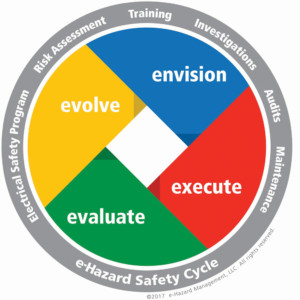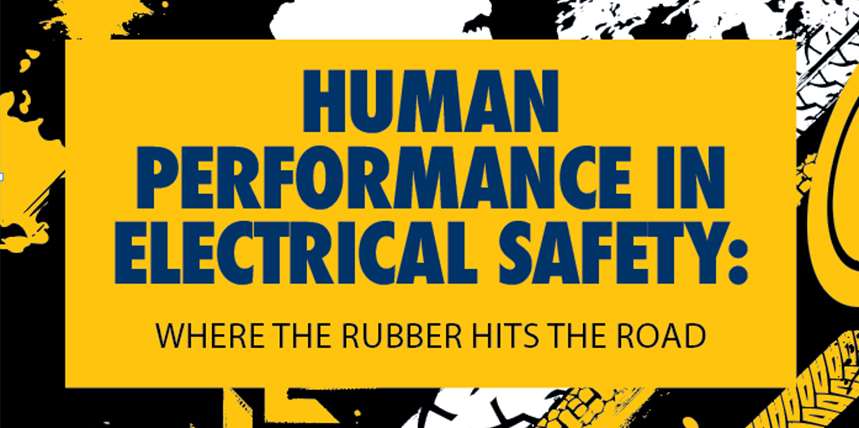Electrical workers, supervisors, and managers are instinctively aware that getting to the root cause of electrical incidents involving the safety of their people and/or the integrity of their equipment requires insightful questions. Failure to find the foundational root cause is a tragedy that compounds the incident itself. Unfortunately, if the first question asks, “Why did it happen?” the answer often has very little to do with the actual root cause.
Root Cause
Calmly and respectfully asking all concerned personnel five or six “why” questions in an ordered fashion will almost always lead to one answer: Human performance followed inadequate best practices. It is guaranteed that the fifth or sixth answer will not be the same as the first answer. If a blame culture is prevalent in the organization, the “why” questions stop very quickly. However, asking “why” as many times as it takes usually points to latent organizational weaknesses, which in turn uncover the fact that the workers involved, the supervisor, and the management system all take some percentage of accountability for the incident.
The first thing the investigation management team must ask themselves is whether any blame will be assigned in this incident. In a strong business and safety culture, the answer is most often “No.” Blame should only be assigned for truly willful and negligent behaviors, which is rarely the case. W. Edwards Deming, a leading management thinker in the quality field, said, “A bad system will beat a good person every time.” Not assigning blame makes it possible to identify the common situations and causes of the incident. Deming also noted, “If you do not know how to ask the right question, you discover nothing.”
These causes and situations can be addressed with human performance tools. For example, in March 1962 in Binghamton, New York, six babies died at General Hospital by salt poisoning. Thirty babies were fed a formula containing salt instead of sugar as a result of a mix-up in filling a nursery container in the main kitchen where large containers of salt and sugar were side-by-side. The containers had significantly worn labels, and the room was dimly lit. Certainly, storing these substances beside each other was an error — a likely situation just waiting to happen. As always, it is far easier to be smart after any incident, but in February 1967, salt instead of sugar was added to the milk formula intended for babies in the newborn nursery of a hospital in suburban Sydney, Australia. Four died; one less severely affected baby made a complete recovery. Unfortunately, there was no Internet back then, and the ability to learn from other tragedies was far less prevalent.
Learning Culture
One way to achieve best-in-class safety and business is to become a learning organization. And one of the best ways to ensure a learning culture is in place is to benchmark against the very best, especially within your sector. Many human performance opportunities have been established by benchmarking the medical industry, where human performance challenges are always prevalent. Based on benchmarking the U.S. airline industry in the 1980s, we know that airline travel is one of the safest methods of travel. The U.S. Department of Energy (DOE) has also been a significant leader in human performance knowledge and best practices. A simple Google search for the DOE and human performance will reveal significant and easily accessed information.
One group that sincerely believes in being a learning organization and using benchmarking as a best practice is the U.S. Navy nuclear submarine group. They clearly understand that an error at any stage of their operations benefits no one, and they advanced human performance best practices and tools as they studied, learned, and benchmarked from others.
When their service in U.S. Navy nuclear submarines ended, many found new careers in U.S. nuclear power plants that believed strongly in being learning organizations, and they improved and implemented the use of leading-edge human performance tools as robust parts of every work plan.
A few of these managers found their way to the Canadian nuclear power plant fleet. Along with intensive World Association of Nuclear Operator (WANO) mandatory audits, the culture of human performance best practices as sourced from the medical and airline industries and the U.S. Navy nuclear submarines found its way into Ontario’s nuclear power plants.
Standards
In 2012, Canada’s CSA Z462, Workplace Electrical Safety Standard Technical Committee began to plan and organize their 2015 edition. At the request of someone who worked in those nuclear power plants, a serious discussion was held regarding a potential annex for human performance. It took a little persuasion, but the decision was made to bring together a group of committed experts, and Informative Annex U: Human Performance & Workplace Electrical Safety was added to CSA Z462 in time for the 2015 edition.
Annex U is one of the jewels of CSA Z462. When people get hurt from electrical energy, they don’t want it to happen again. If you ask “why” enough times, you will inevitably find a situation caused by a less-than-adequate human-performance error at some level.
The CSA Z462 Technical Committee entered a Public Input (PI) into the NFPA 70E system in time for the 2015 edition, but it was not accepted; however, the 70E Technical Committee did accept this PI in its 2018 edition. Now that human performance best practices are strongly in place across North America, it is an important best practice for leading-edge electrical business units. The higher-voltage utility sector has also made concerted efforts to embrace human performance tools and best practices in the last few years.
Many concepts and theories within the realm of human performance are discussed in the electrical sector. Electrical people are practical and pragmatic. While they enjoy the theory up to a point, they like to get things done in a hands-on manner. One challenge has been turning human-performance information into something that can be used on a day-to-day basis in quality job planning.
In 2018, ISO issued a new health and safety management system standard that supersedes OHSAS 18001, CSA Z1000, and ANSI Z10 in many workplaces. ISO 45001, Occupational Health & Safety outlines requirements for OH&S management systems, gives guidance for use, and helps business units provide healthy and safe workplaces. Any good electrical safety program can and must be established on the foundation of a health and safety management system. A company’s electrical safety program should be a subset of the overall health and safety program along with any other hazards that exist in a specific workplace.
Safety Cycle
W. Edwards Deming crafted the basic architecture for health and safety management systems: Plan, Do, Check, Act. The basic premise is one of continual improvement. One last quote from Deming has always been true: “All organizations are perfectly aligned to get the results they get.”

Figure 1: Safety Cycle
An adaptation of the similar structure (Figure 1) emphasizes the importance of a strong safety management system foundation. The safety cycle includes most components of a safety management system. All subsets including the electrical safety program, risk assessments, training, investigations, audits, and maintenance are impacted negatively if practical human performance tools (not just concepts) are not established on a day-to-day basis.
Human Performance Tools
A critical finding by a leading-edge Ontario-based nuclear power plant was to focus on a lower number of human performance tools rather than using too many. They found that concentrating on approximately four effective human performance tools was significantly more efficient in day-to-day planning of safe and timely work tasks.
Here are four examples of opportunities to work a few human performance tools into day-to-day work planning under the umbrella of safety management system principles. Others may also work well within your organization.
Envision
The Job Safety Planning sections of CSA Z462 and NFPA 70E may be the most valuable parts. Job safety planning shall be completed by a qualified person; it shall be documented, describe the job and the hazards, and include shock and arc flash risk assessment procedures. Work procedures, precautions, and lockout/tag out provisions are also required. A strong and robust electrical safety program ensures these planning components are an integral part of the safety management system.
In many businesses, routine management Task Demands are an Error Precursor that prevents the development of a robust electrical safety program. It is critical to understand that less-than-adequate human performance issues are not just a worker concern. Workers, supervisors, middle managers, and senior executive teams may have similar human performance weaknesses within the tasks in their purview.
The human performance tool of Effective Communications may not be practiced by the upper managers who are most accountable to ensure that an effective electrical safety program is in place. They must listen to the best practices coming from the electrical sector, their competitors, and their regulators and take advantage of the learning opportunities as they practice benchmarking throughout their sector.
Execute
Execution of daily job safety planning is where the rubber does hit the road. Staff must get the job done safely and on time. A strong case can be made for any number of Error Precursors at the execution phase of any electrical task:
- Individual Capabilities to execute any job can be a significant error precursor. As we all know, many very experienced long-term employees are retiring and will continue to leave the current workforce in droves over the next few years. It is not uncommon to have older workers plus lots of new and younger workers but not very many in between. Comprehensive and effective training on shock and arc flash risk assessment procedures as core competencies is critical. These skill sets can absolutely affect the execution of work.
- STOP When Unsure is a valuable mandatory human performance tool. This must come from the very top of the organization. Everyone from managers on down must understand clearly that is it okay and expected to stop when you’re not sure. When people don’t feel comfortable doing this, execution of a work task is going to exhibit significant problems sooner or later. It is a basic human performance tool of great worth.
Evaluate
The third and often overlooked section of the cycle is evaluation and audit. When a supervisor or middle manager is asked “Are your staff working safely?” the inevitable answer is “Yes, I watch them do it all the time.” That is an outstanding — and correct — answer, but the second question is “Have you documented your evaluation?” A classic truism for safety is that if it hasn’t been documented, it didn’t happen. Documented evaluations or audits are facts. Opinions and verbalizations are not.
Work Environment is a classic error precursor in the evaluation process. A work environment that does not document evaluations is not best in class. Any evaluation in the workplace must be done in a respectful, professional manner not underlined by a blame culture. Procedural Use and Adherance is an effective tool to document evaluations and audits and follow up on a comprehensive corrective action plan (CAP). A CAP clearly states the problem, how it is to be corrected, and who will correct it. It names a specific deliverable date and the manager accountable to ensure it all happens as documented. This is Management 101.
Evolve
The last important segment of the continuous cycle of human performance opportunities is constant evolution of management actions based on observations in the evaluation segment. The evolution of management actions is very important in the feedback loop within a health and safety management system. CSA Z462 and NFPA 70E are nicely aligned with this cycle as perfectly described in ISO 45001.
Human Nature must be understood as a human performance error precursor at this management stage. It is human nature to get very busy doing all the right things but not follow up. Procrastination is common. Once electrical safety improvements have been planned, executed, and audited, they must be diligently maintained and followed up. Repeat Back is an outstanding tool at this stage. Senior management repeats back exactly what was stated and agreed to in the audit CAP. Repeat backs provide clarity versus murkiness or vagueness.
Conclusion
Maintenance of the electrical health and safety management system is driven by the continual improvement process of Envision, Execute, Evaluate, and Evolve. Maintaining your safety cycle by understanding the value of human performance tools in day-to-day operations will fill in what every worker, supervisor, manager and senior executive team instinctively knows: Human performance is where the rubber hits the road.
 Mike Doherty is President of Blue Arc Electrical Safety Technologies Inc. He has 45 years of industrial and electrical utility experience as an instrumentation technician, licensed electrician, training professional, electrical utility safety professional, and electrical safety consultant. Mike is an IEEE Senior Member; Chair of ULC CAN/ULC-S801, Standard on Electric Utility Workplace Electrical Safety for Generation, Transmission and Distribution. He was Chair of CSA Z462 Technical Committee Workplace Electrical Safety Canada from 2006–2018 and continues to serve as a voting member. Mike received the 2019 IEEE Electrical Safety Workshops Outstanding Service Award.
Mike Doherty is President of Blue Arc Electrical Safety Technologies Inc. He has 45 years of industrial and electrical utility experience as an instrumentation technician, licensed electrician, training professional, electrical utility safety professional, and electrical safety consultant. Mike is an IEEE Senior Member; Chair of ULC CAN/ULC-S801, Standard on Electric Utility Workplace Electrical Safety for Generation, Transmission and Distribution. He was Chair of CSA Z462 Technical Committee Workplace Electrical Safety Canada from 2006–2018 and continues to serve as a voting member. Mike received the 2019 IEEE Electrical Safety Workshops Outstanding Service Award.
